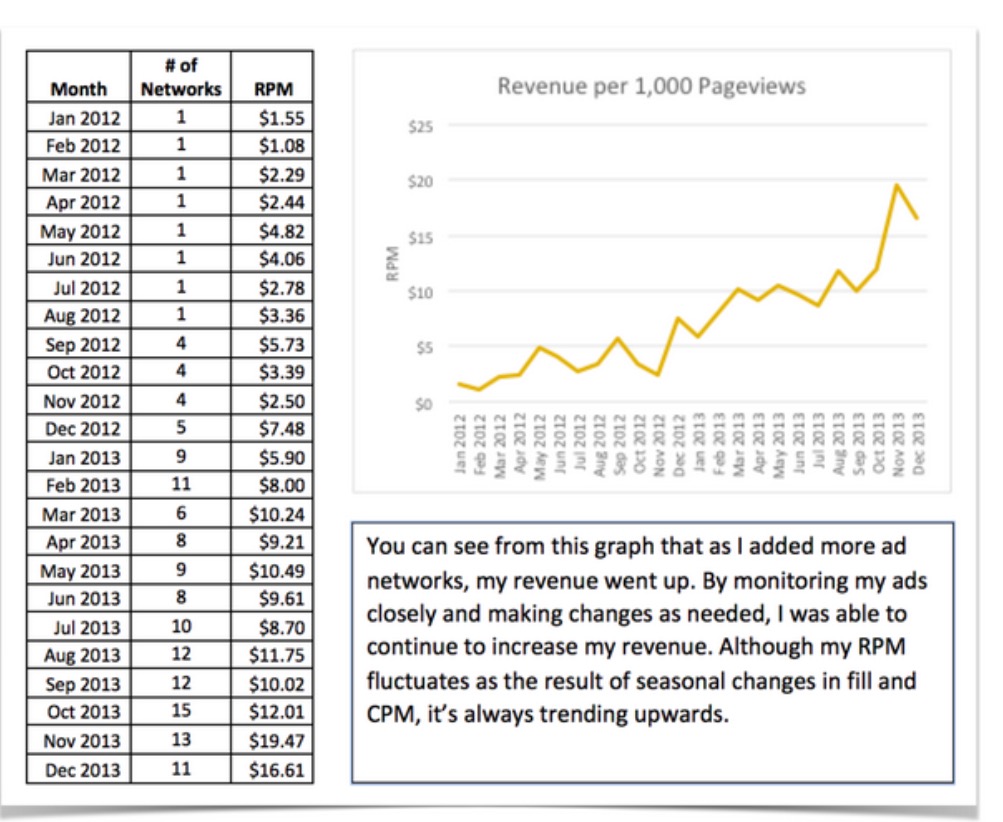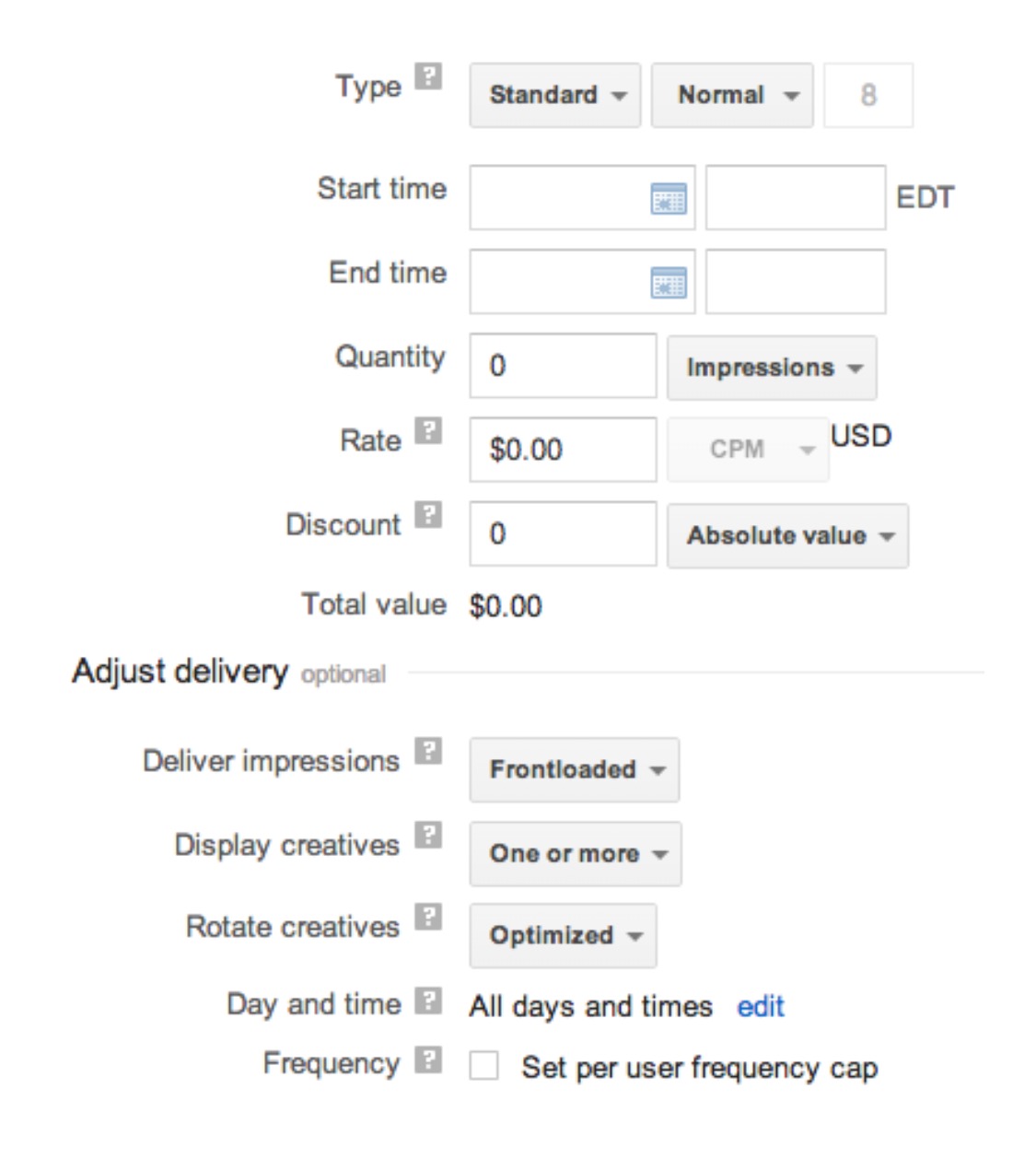
Allow us to illuminate you!
Since January I’ve been experimenting with the ads on Abby’s site. You can see from our past income reports that ad networks are an important part of our blog income. Unfortunately I have been less than systematic over the past 6 months with my ad strategy. So while I’ve done a lot of tweaking and changing, I haven’t been diligent in keeping track of what works and what doesn’t.
Ad Revenue History
March 2013 – $9
April 2013 – $21
May 2013 – $65
June 2013 – $50
July 2013 – $124
August 2013 – $88
September 2013 – $71
October 2013 – $104
November 2013 – $208
December 2013 – $239
January 2014 – $404
February 2014 – $645
March 2014 – $589
April 2014 – $633
May 2014 – $746
June 2014- $727
To me, that’s pretty disappointing ad revenue growth in 2014. Especially when I hear from other bloggers that with about 200,000 pageviews/month (Abby’s traffic) we should earn double, if not triple, the ad revenue you see above. When I hear that, of course I ask what strategy they are using. What I’ve learned is that there is no single right ad monetization strategy. There are some bad strategies (mine) but also many great strategies! Let’s look at five options.
Disclaimer – I am not an ad network expert, I just pretend to be one on the internet. If you have an opinion that differs from what is presented here, I would LOVE to hear about it in the comments.
1. AdSense Only
This is the easiest way to get started. Google’s AdSense is a huge ad network and their simple dashboard makes it easy to get started– just create the ad unit size you want and copy and paste the code into WordPress. You start earning money instantly and they pay out on the 24th of the month following your earnings once you reach the $100 threshold.
I placed my first AdSense code on Abby’s blog a little over a year ago. It took us months to get that first $100. It was an exciting day when it finally happened! I still remember a day in April of last year when we earned $5. That was a huge surge for us and was tremendously motivating!
Over the past year I’ve constantly tweaked ad placement and have learned a lot in the process. But the whole time the only network I used was Adsense.
For a detailed look at how we use AdSense and how you can too, read chapter 23 in Abby’s eBook.
If you are just starting out, remember, one of the best things about Adsense (unlike most ad networks) is that there is no specific traffic requirement. You can get approved with virtually no traffic. It’s a great way to get started.
2. Multiple Ad Networks
This is the stage Abby and I are currently in, although not for long. Because Google only allows 3 ads per page and we wanted to have more than 3 ads on our site we applied to other ad networks. If you look at Abby’s blog today you’ll see 7 ad units displayed, depending on the page and fill-rate. 3 are AdSense ads, and 4 are ads from other networks.
The performance of these “other” ad networks has varied wildly! It’s almost unbelievable. We’ll apply to and get approved for a new network only to realize a few days later that we are getting pennies for thousands and thousands of impressions. But other networks seem to do really well for us.
Despite the hit-and-miss success of additional ad networks, this is a good next step up from running only AdSense. It allows you to increase the number of ads and compare your numbers across multiple networks, but this is still an imperfect strategy. The ad space is never 100% filled and there is no way to tell what ad network will perform best in a certain location. There is too much guesswork with too many decisions to make.
For a list of some of the better ad network options see this new page.
3. Waterfall Technique with Multiple Ad Networks
I first learned about this strategy while reading the eBook How to Monetize a Food Blog. In fact, the section on advertising was the only reason I purchased the book!
One of the problems with assigning one ad network to certain location on your blog is that you run the risk of not filling the ad space 100% of the time. It’s very common to have a network with 30% to 70% ad fill rate. This is not good. You’re missing out on 30% to 70% of your ad revenue.
The waterfall technique or “ad backfill” works by assigning multiple ad networks to a single space on your blog. If one of the networks can’t fill the space, the ad tag moves on to the next network in your pre-assigned hierarchy.
An ad tag is a bit of code that instructs the web browser to retrieve an ad from a specified ad server. The idea is to give your best ad network the first shot at filling the space. If this network has no ads to serve up above your pre-defined CPM threshold, the tag directs the browser to retrieve an ad from the second best ad network at a specified CPM or higher. The process keeps going down the waterfall until it finds an ad!
A CPM is “cost per thousand” impressions. The “M” stands for “mille”, or 1,000. So the higher the CPM, the better. The top ad network in the waterfall should pay you the highest CPM and then on down from there.
The last ad network in the chain should always have a 100% fill rate. AdSense is an example of a network with 100% fill rate. But even having a 100% fill rate isn’t always a guaranteed thing. I’m looking at Abby’s blog right now and I see that all of her Adsense ads are displaying ads for other google products. If I had to guess, I would say these “house” ads don’t pay a whole a lot.
So even while Adsense has a 100% fill rate, other ad networks can potentially serve up ads with a much higher CPM, earning you more money.
Does this strategy work? Absolutely. It’s a huge improvement over strategy number two.
Take a look at this screenshot from a Pinch of Yum income report. The author of How to Monetize a Food Blog, Kiersten Frase, was a guest contributor on this particular day. You can clearly see that as she added additional ad networks her ad revenue would increase. Please note she is not tracking CPM but another metric that looks at her overall ad revenue.
If you decide to buy Kiersten’s eBook, make sure you do it through one of the affiliate links on Pinch of Yum. Bjork and Lindsay put out a ton of great information and I found Kiersten’s blog and eBook through their site. I think the eBook is the best place to start if you want to implement this strategy.
The difficult part about the “waterfall” strategy is that it requires constant monitoring and tweaking. There is nothing set-it-and-forget-it about it. You have to make a conscious decision about the order of your ad networks and the CPM thresholds to use.
Some of the biggest blogs use this strategy but it’s not without its faults. In the real world, CPMs between ad networks rarely stay the same and changing the tags and order of ad networks is a manual process.
4. Managed Ads
This one is simple. You pay a person or a company to manage your ads for you.
This is a great strategy for those who don’t want to spend time messing with ads and would rather focus on content. If I wasn’t helping Abby with her blog, this is the strategy I would recommend for her. Her focus should be on creating content and connecting with other bloggers, not trying to optimize ad networks. But fortunately (or unfortunately!) she has me to mess around with all this stuff.
Besides the incredible time savings, many of these companies have access to ad networks that otherwise would not be available to you. For instance, some ad networks require 1,000,000+ pageviews/ month to participate. On your own this may be out of the question but you could gain access to these networks by working with an ad managing company. These premium networks have the chance to dramatically increase your CPM.
At this point there are only two managed ad services that I would consider. Not because these are the only two good ones, but because these are the two that I’m most familiar and comfortable with. I have no first hand experience but a lot of anecdotal evidence from other bloggers I trust that these are good and reputable companies.
1. The Blogger Network
One of Abby’s friends, Lauren, told me about this service. The Blogger Network describes themselves as “holistic ad management.” Depending on their performance you’ll pay anywhere from 5% to 20% of your ad revenue for their management services. This comes directly out of your earnings.
2. Ad Thrive
The husband of one of Abby’s blogging friends started this service. It’s similar to The Blogger Network but Ad Thrive only collects money by placing one of their ads below your footer. This is not a prime location so it’s hard to tell what percentage of an overall ad strategy this works out to.
Right now Ad Thrive requires 100,000 minimum monthly pageviews / month to work with them. There’s some talk that they may lower that number in the future.
Update as of 2/12/2015: Abby and I are now using AdThrive to manage our ads and we couldn’t be happier! We started with them in October of 2014 and our ad revenue has continued to grow and grow.
5. Google DFP
To many this is the ultimate solution! I may or may not agree but so far it’s been a bear trying to figure out and find good resources on DFP.
What is Google DFP? It’s a free ad server. You can run all of your ad networks through this server and use it as a central location for managing all your ads. The HUGE benefit is that this allows you to have multiple ad networks targeted at a single space on your website. Just like the “waterfall” technique, this is done in order to ensure a near 100% fill rate.
It gets even better… With the right settings in DFP it’s possible to have ad networks dynamically compete against each other for impressions. So instead of a pre-defined pecking order with a waterfall, DFP can give all your ad networks an equal opportunity to serve up an ad with the highest CPM.
Sounds amazing, right? Well it is. The problem with DFP is the intimidation and lack of good resources on the subject. I mean just look at some “basic” DFP settings below. What?!
The problem is that it feels incredibly complicated to set this up. Documentation seems lacking and when I log into DFP I am immediately overwhelmed and just have no idea where to start.
Where to Go From Here?
That’s up to you but I’ll offer some thoughts…If you have 1,000 pageviews / day or less, I would start with Adsense. Test and tweak ad placement and get familiar with placing the code into your blog.
Some would suggest to not even bother with ads until you have a couple thousand views per day. I disagree. It can be incredibly motivating just to earn a few dollars from ads everyday. It could be just the inspiration needed to keep pushing forward.
It wasn’t that long ago that I was shocked and amazed that google was actually sending Abby money. It was the first income we ever made from her blog and it opened us up to a whole world of possibilities.
To be honest, we had the same level of excitement then as we do now earning five, six, or seven hundred a month from Adsense. Don’t begrudge a few dollars a day.
If you are getting more than 1,000 pageviews / day it’s time to start applying to other ad networks. It only takes 5 minutes to apply to most networks but make sure you keep track of networks, application date, and login information in a Google Doc spreadsheet or Evernote so you don’t lose track.
In my experience it never hurts to apply for as many ad networks as you can. Unless they have a binding contract or some exclusivity rule it never hurts to test out their network and see how they stack up.
Pick a spot on your blog to test networks. I recommend a 300×250 ad on the very bottom of your sidebar. Run a test for a few days, making sure to keep track of fill rate, CPM, earnings, and any other metrics the ad network provides to you. I use a Google Doc spreadsheet for this as well. If you decide to use the “waterfall technique” this will be valuable data when determining the hierarchy of your ad networks. Again, here’s a list of some ad networks you can start with.
By Just a Girl and her blog
Which of the above 5 ad monetization methods are you using?
If you’ve tried any of the above then you know how incredibly tough it is to generate a lot of income especially if you have plans to get super wealthy.
Our sixth way to monetize your blog is truly incredible. It’s a system set up by the Slay Network specifically to help everyday people generate immense wealth. Its very simple you join the slay black membership program ($150 a month or $1800 per year) and you recruit other members to the program. Your membership is credited to your Slay Network account which you can use to purchase items in the luxury online Slay store. You then recruit other members to do the same and their credit will also be credited to their respective accounts. Now get this, for each member you recruit you earn 50% commissions every single month for the rest of your life. In addition you get a free slogger channel on this luxury platform, which is like a free blog to help you expand your efforts. It’s a truly amazing opportunity, one you dare not miss out on before they set minimum traffic levels to qualify. Click here to join this lucrative program now.







